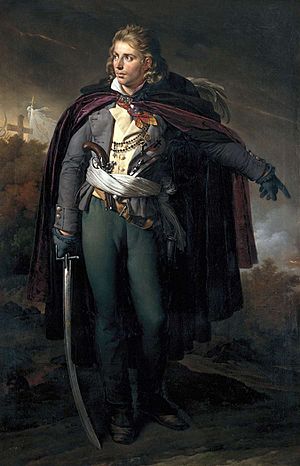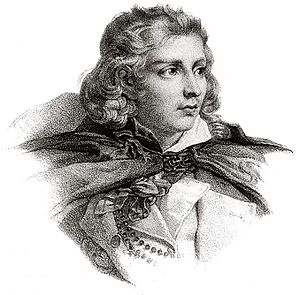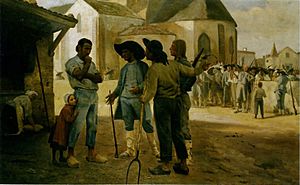Jacques Cathelineau facts for kids
Quick facts for kids
Jacques Cathelineau
|
|
|---|---|

Jacques Cathelineau (1759-1793), généralissime vendéen, by Girodet (1816)
|
|
| Nickname(s) | the Saint of Anjou |
| Born | 5 January 1759 Le Pin-en-Mauges, Kingdom of France |
| Died | 14 July 1793 (aged 34) Saint-Florent-le-Vieil, French First Republic |
| Allegiance | |
| Years of service | 1793 |
| Rank | Generalissimo |
| Commands held | Catholic and Royal Army |
| Battles/wars | War in the Vendée
|
Jacques Cathelineau (born January 5, 1759 – died July 14, 1793) was a French leader during the French Revolution. He led a group of people from the Vendée region who were against the new government. His followers called him the Saint of Anjou.
Cathelineau was a traveling salesman in the Anjou area. When the old French kingdom was replaced by the French First Republic, many people in the Vendée suffered. This was during a time called the Reign of Terror. Cathelineau brought together an army of farmers who supported the king and the Church. They fought against the new government. His army captured several towns and castles, and more people joined them.
As the fight grew, Cathelineau joined forces with other leaders. He was made generalissimo, which means the supreme commander, of the Catholic and Royal Army. He inspired his soldiers by fighting bravely alongside them. In the summer of 1793, while attacking the city of Nantes, Cathelineau was shot by a sniper. He died soon after. Without his leadership, his army was defeated. Later, his family was given a special honor because of his bravery.
Contents
Life of Jacques Cathelineau
Early Years and Beliefs
Jacques Cathelineau was born in Le Pin-en-Mauges, France. He was well known in the Anjou region. He traveled around as a salesman. Cathelineau was a very religious Catholic. He believed strongly in the Church's traditional role in French society. People respected him for his physical strength, his ability to lead, and his strong faith.
In the early years of the French Revolution, many farmers in Vendée were unhappy. They disliked new laws about the Church and rules about joining the army. They were also upset when King Louis XVI of France was executed. Cathelineau gathered an army of farmers. He started his own fight against the new government of the First French Republic.
Starting the Rebellion
As the fighting continued, the people of Vendée became very angry. They heard about attacks on Catholic priests and other Vendéans by the revolutionaries. On March 10, 1793, young people in Saint-Florent-le-Vieil rebelled. They fought against the local government forces. When Cathelineau heard this, he left his home. He gathered his neighbors and convinced them to fight the Republicans. He believed this was the only way to stop the Reign of Terror.
On March 12, twenty-seven young men followed him. They quickly found weapons and marched towards Jallais. They spread the word, and more farmers joined them. On March 13, they reached Jallais. The town was defended by 80 Republicans and a cannon. Cathelineau's group captured the castle and took the cannon. They called it "The Missionary." Soon after, they also captured the town of Chemillé on March 14. Many more volunteers joined Cathelineau's troops.
By March 14, he had 3,000 men. With the help of Jean-Nicolas Stofflet, he marched on Cholet and won again. After this, they joined other Vendéan leaders, Charles de Bonchamps and Maurice d'Elbée. Cathelineau continued to have a big impact on the farmers. The Royalists captured Vihiers and Chalonnes. The fighting then stopped for a short time as people went home to celebrate Easter.
On April 9, his groups were ready to fight again. But they had to leave Chemillé and go back to Tiffauges. With 3,000 men, he joined Stofflet. They took Cholet, Vihiers, and Chalonnes again. He captured Beaupréau on April 23. They also won the Battle of Thouars on May 5. On May 14, they were pushed back to La Châtaigneraie. The Vendéens were defeated in Fontenay-le-Comte on May 16. Cathelineau fought back. He defeated the Republicans at Montreuil-Bellay and Saumur on June 9, 1793.
After the Battle of Saumur and taking the city, the rebellion became very important. The Royalist leaders decided they needed one main commander. The soldiers loved Cathelineau. So, on June 12, 1793, he was named generalissimo of the Catholic and Royal Army. This made the farmers even more inspired, as one of their own was leading the army.
His Final Battle and Death
After passing Angers easily on June 23, 1793, the combined Catholic and Royal Army attacked Nantes on June 29. Cathelineau arrived at Nantes with 40,000 men. Another leader, Charette, helped him with 10,000 more fighters. Cathelineau entered the city despite strong resistance. He attacked the gate of Rennes. As he moved into Place Viarme, a sniper shot him from a window. He was badly wounded.
With their leader hurt, the Vendéan army was defeated. They soon split into different groups. Cathelineau was taken to Saint-Florent-le-Vieil. He died from his wounds on July 14, 1793. His body is buried in the Cathelineau Chapel in Saint-Florent.
Many of Cathelineau's relatives also died in the Vendée war. After the war, the rest of his family was given special noble status. His son, Jacques-Joseph Cathelineau, was knighted. His grandson, Henry Cathelineau, was an officer in a later war.
Honoring Cathelineau
Because of Cathelineau's strong faith and bravery, some people wanted him to be recognized as a saint. This idea came up in the late 1800s. Sadly, important records about this process were lost in a fire during World War II. Even though the Church has not officially recognized him as a saint, many people still see him as a very holy man.
See also
 In Spanish: Jacques Cathelineau para niños
In Spanish: Jacques Cathelineau para niños




